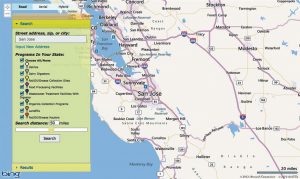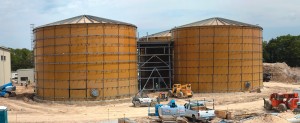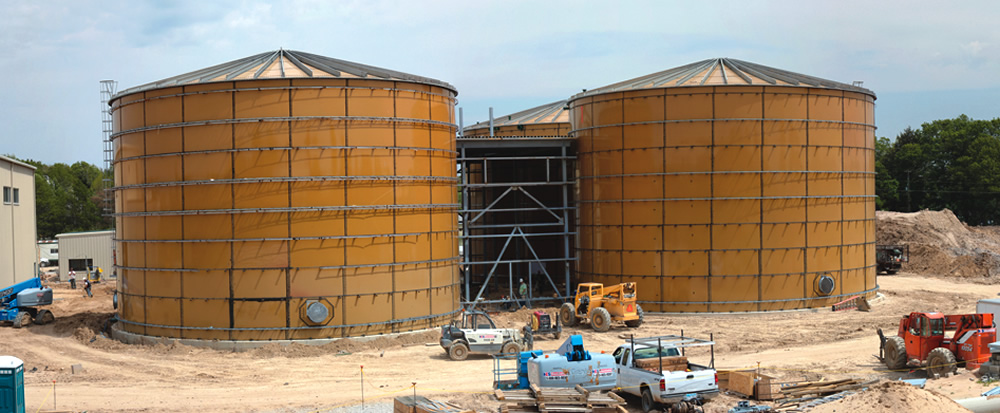BioCycle July 2012, Vol. 53, No. 7, p. 14
San Francisco, California: Organic Residuals To Biogas Mapping Tool
 USEPA Region 9 (Pacific Southwest) has launched an online Waste to Biogas Mapping Tool (W2B), an interactive map created to connect organic waste producers (e.g. grease-rendering or food processing facilities) and potential users (e.g. wastewater treatment facilities (WWTF) operating anaerobic digesters) for the purpose of biogas production through codigestion. W2B maps California, Arizona, Nevada and Hawaii, the four states that comprise Region 9. Since May, W2B has been providing new and updated information for the following categories: Food processing facilities, FOG (fats, oils & grease) collection sites, dairies, dairies with digesters and WWTFs. Two newer categories have also been created: FOG haulers and landfills. “This innovative mapping tool, the first of its kind in the nation, helps restaurants, hotels and other food waste generators to connect with large energy producers,” says Jared Blumenfeld, EPA Regional Administrator for the Pacific Southwest. Coupled with the tool’s ability to determine the proximity of organic waste producers, the updates enhance a user’s ability to assess the suitability of biogas projects, particularly those involving codigestion. The tool can be found at www.epa.gov/region09/biogas.
USEPA Region 9 (Pacific Southwest) has launched an online Waste to Biogas Mapping Tool (W2B), an interactive map created to connect organic waste producers (e.g. grease-rendering or food processing facilities) and potential users (e.g. wastewater treatment facilities (WWTF) operating anaerobic digesters) for the purpose of biogas production through codigestion. W2B maps California, Arizona, Nevada and Hawaii, the four states that comprise Region 9. Since May, W2B has been providing new and updated information for the following categories: Food processing facilities, FOG (fats, oils & grease) collection sites, dairies, dairies with digesters and WWTFs. Two newer categories have also been created: FOG haulers and landfills. “This innovative mapping tool, the first of its kind in the nation, helps restaurants, hotels and other food waste generators to connect with large energy producers,” says Jared Blumenfeld, EPA Regional Administrator for the Pacific Southwest. Coupled with the tool’s ability to determine the proximity of organic waste producers, the updates enhance a user’s ability to assess the suitability of biogas projects, particularly those involving codigestion. The tool can be found at www.epa.gov/region09/biogas.
Collinwood, Ohio: Digester Starts On Former Brownfield
Forest City Enterprises, a $9 billion publicly traded real estate company based in Cleveland, and Ohio-based quasar energy group partnered to develop an anaerobic digestion (AD) facility on a 60-acre site that was once the location of a General Motors Fisher Body Plant. The facility is utilizing quasar’s 908,000-gallon ecoCity system to process 117 wet tons/day of mixed biomass. The plant has the potential to generate 1.3 MW of electricity and 34,515 MMBtu of thermal heat annually, according to quasar. The electricity will be sold to Cleveland Public Power. A renewable CNG fueling station — qng or quasar natural gas — also was installed. “The community has been interested in redeveloping the site for a long time,” says Forest City project manager Rick Gerling, adding that the company believes the AD component of the project will attract businesses to the site. “We see this as a first step in creating an energy park around renewables.” Potential businesses include renewable energy companies or industries such as food processors or breweries with waste that could be used as feedstock for the digesters. The facility’s grand opening was held on July 9.
The Collinwood project is viewed as a case study for the larger deployment of bioenergy projects within the Forest City portfolio. “We see this as a repeatable business model in different locations where we have sites like this,” adds Gerling. Digesters could also provide energy to some of the larger buildings within that portfolio, he says, such as shopping malls. In December, the Collinwood project received a $1 million grant commitment from the Ohio Department of Development, funded through the American Recovery and Reinvestment Act’s State Energy Program. Quasar has an equity stake in the project, which it built and is operating.
Fremont, Michigan: Community Digester On Track
 Novi Energy’s $22 million Fremont Community Digester project in western Michigan is nearing completion and is scheduled to begin taking organics — mostly food processing waste — from Gerber and half a dozen other food manufacturers with significant organic waste streams sometime in August. Novi CEO Anand Gangadharan says the company has locked in 100,000 tons/year of feedstock, with no more than 15 percent of it coming from any one source. “The banks like the fact that our feedstock sources are diverse,” he says. “They wanted long-term contracts, and we’ve got some of those, for 20 and even 30 years, but many are shorter.” That flexibility, he says, allows Novi Energy leeway to do business with established companies as well as start-ups.
Novi Energy’s $22 million Fremont Community Digester project in western Michigan is nearing completion and is scheduled to begin taking organics — mostly food processing waste — from Gerber and half a dozen other food manufacturers with significant organic waste streams sometime in August. Novi CEO Anand Gangadharan says the company has locked in 100,000 tons/year of feedstock, with no more than 15 percent of it coming from any one source. “The banks like the fact that our feedstock sources are diverse,” he says. “They wanted long-term contracts, and we’ve got some of those, for 20 and even 30 years, but many are shorter.” That flexibility, he says, allows Novi Energy leeway to do business with established companies as well as start-ups.
Feedstocks will include fruits, vegetables, cheese whey, alcohols, glycerin, meat processing waste, pharmaceuticals, biofuels residuals and agricultural wastes such as livestock manure. The digester system, supplied by a company in Denmark, includes three tanks, and can switch between thermophilic and mesophilic when necessary. Feedstocks will be received in enclosed buildings with negative air pressure and biofilters to manage odors. Biogas produced at the 15-acre site will drive two GE Jenbacher engines with a combined 3 MW of electricity generating capacity. Novi Energy has entered into long-term power purchase agreement with Michigan-based Consumer Energy for the electric output.
Funding for the Freemont Community Digester included a 9003 loan guarantee from the USDA’s Biorefinery Assistance Program and a 1603 U.S. Department of Treasury grant that covers up to one third of eligible capital costs. A local farmers co-op also took the opportunity to make a small equity investment in the project. “It has worked out well for us,” says Gangadharan. “We’ve got people in the community investing in the project, supporting us and helping to identify feedstock. It’s a nice model.”
Boulder, Colorado: Biogas Projected To Be $33 Billion Industry By 2022
According to a new report from Pike Research, “Renewable Biogas,” the biogas market reached $17.3 billion in global revenue in 2011 and will nearly double by 2022, hitting $33.1 billion in that year. The report analyzes the global market opportunity for biogas capture across four key industrial segments — municipal solid waste, agriculture, industrial and sewage treatment — and includes both landfill and digester biogas. “With the relatively mature German biogas market nearing saturation, many design-build firms and project developers are seeking to export their expertise abroad to tap opportunities across Europe, the Americas, and Asia Pacific,” says Mackinnon Lawrence, senior analyst at Pike Research. “Increasing demand among farmers, municipalities, and industrial processors for waste treatment technologies, on the one hand, and widening opportunities for renewable natural gas in transportation and cogeneration applications on the other, signal steady growth for the biogas industry over the next decade.” Conditioned and compressed biogas is a renewable fuel that has the potential to satisfy advanced biofuels mandates under the Renewable Fuel Standard (RFS2) and emerging Low Carbon Fuel Standards (LCFS).
Global installed production capacity is now more than 800 billion cubic feet/year, representing nearly 14.5 gigawatts (GW) of installed distributed and grid-scale renewable generation capacity, according to Pike Research. “With at least 11 billion cubic feet/year of production capacity expected to come online worldwide by the end of 2012, renewable natural gas (RNG) is a growing segment within the diverse biogas landscape,” explains Lawrence.
Oshkosh, Wisconsin: Dairy Farm To Test Small-Scale AD
Allen Farms recently received a $125,000 grant for a feasibility study from the Wisconsin State Department of Administration and will get additional funding from the University of Wisconsin (UW) Oshkosh Foundation to install a BIOFerm Energy Systems “plug and play” EUCOlino small containerized anaerobic digester to produce electricity from the combined manure of 130 cows. “We’ve been sending bedded pack manure to the dry digester at the UW Oshkosh, says dairy farmer Dave Allen, adding that through this evolving relationship, the UW Oshkosh Foundation identified his farm as an ideal location to invest in smaller-scale digester research.
Allen explains part of that evolution involves recognition that with the state’s leadership role in the AD arena, it only makes sense to train engineers and technicians locally. “BIOFerm basically told the Foundation: ‘We are going to need to educate people about how to work on digesters and run them,’” he says. Currently, off-farm feedstock (such as food waste) will be added to the small-scale wet digester, equipped with a 55 kW engine. Digestate will be land applied to local cropland without separation. Generated electricity will be enough to power the farm and additional Wisconsin homes. Manure feedstock also will be supplied by two other nearby farms. It will be the first installation of EUCOlino technology, specifically designed for dairy herd sizes between 50 and 500 animals, in the United States. “It is exciting to see our state support a feasibility study that will examine what it takes to ingrain renewable energy innovations that we are helping establish in larger on-and-off-campus digesters into a smaller farming operation like Allen Farms,” says Tom Sonnleitner, UW Oshkosh Vice Chancellor of Administrative Services.
Sacramento, California: AD Projects Receive Grants
Clean World Partners received a $6 million grant from the California Energy Commission (CEC) in mid-June to increase the capacity of its Organic Waste Recycling Center at Sacramento County’s South Area Transfer Station. The company broke ground June 7 on a high solids anaerobic digestion facility designed to process an average of 25 tons/day (tpd) of food waste from local food processing companies, restaurants and supermarkets. The financial boost enables the project to expand to 100 tpd. “Clean World Partners is clearly demonstrating that its waste-recycling systems can be used in a wide range of situations,” said Energy Commissioner Carla Peterman. “We’re pleased to support expansion of this new facility in Sacramento and are excited about its growing influence in the waste recycling market.”
The CEC also awarded Sacramento-based Atlas Disposal Industries a $300,000 grant to support construction of an anaerobic digestion-based Renewable Natural Gas (RNG) Fueling Station, also at South Area Transfer Station. Atlas Disposal is collecting food waste for the digester, and will use the biogas to produce the RNG. The fuel will be used for the company’s trash collection fleet, as well as school buses and other vehicles from area jurisdictions and agencies. Electricity needed to run the fueling station will be generated by the Organic Waste Recycling Center operated adjacent to the transfer station. Atlas Disposal says the initial 25-tpd digester operation will produce 164,000 diesel gallon equivalents annually. The two facilities combined are expected to create 16 local long-term jobs and generate more than $1.1 million in annual combined tax revenue for the city, county and state.










